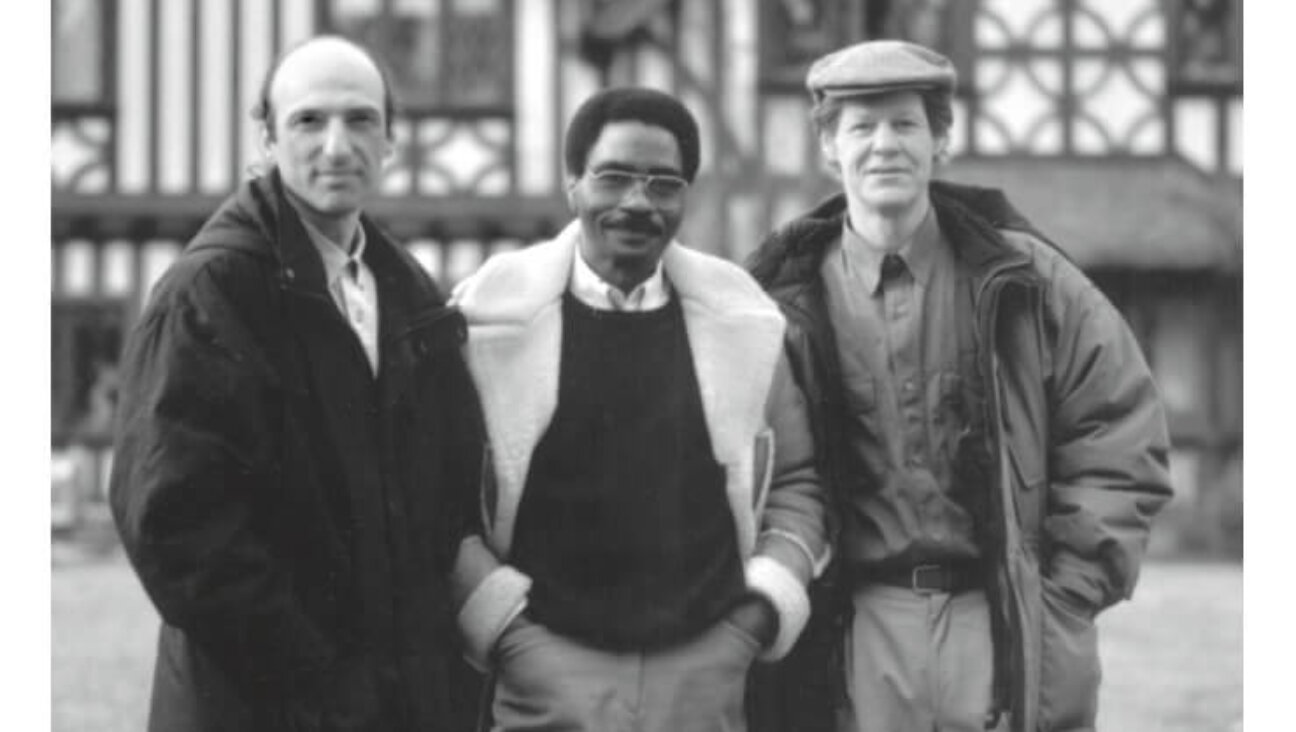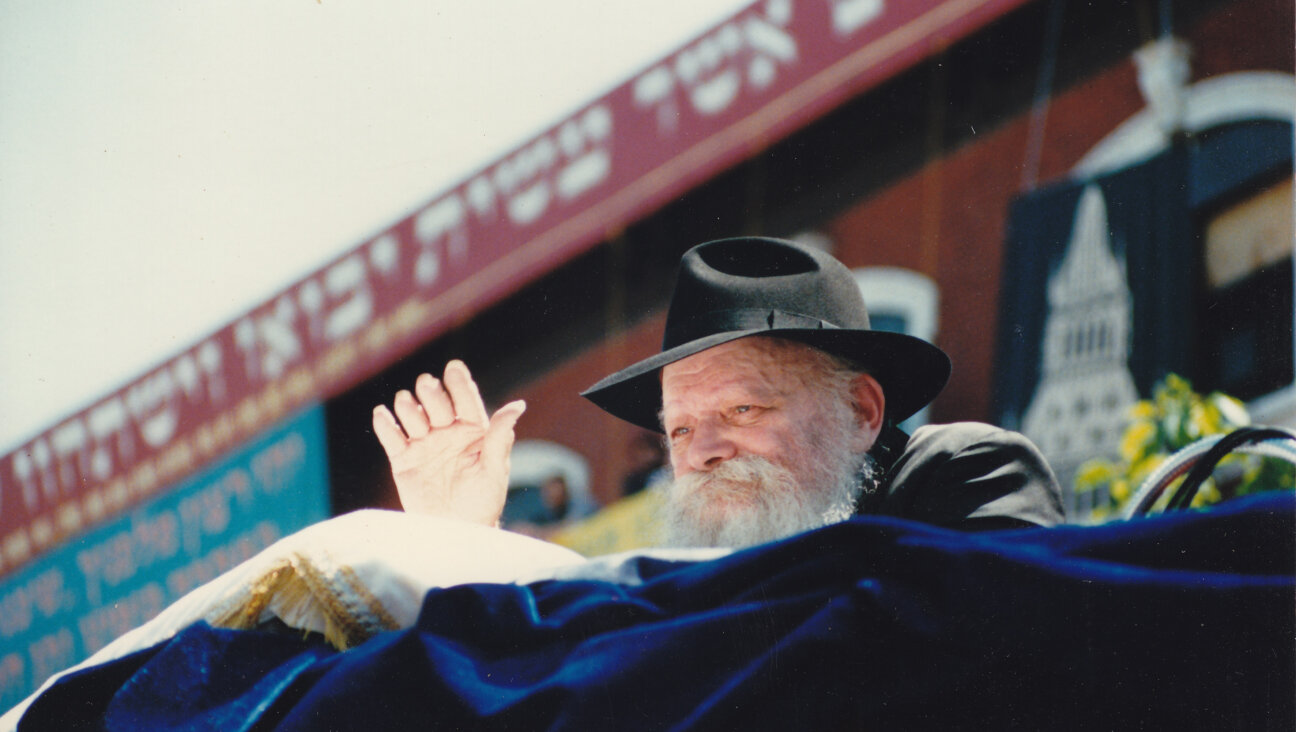Superstition Vies With Faith at Yiddish New York

Image by Courtesy of Deborah Ugoretz and Tine Kindermann
There they are, in Sanford Drob’s “Expulsion:” a man and woman, draped in animal skins, seized with grief – the woman gazing forward, determined but horrified, the man covering his face with his hand – and wearing armbands emblazoned with yellow Jewish stars, the word “Jude” at their centers.
It’s a painting that, despite the obviousness of its concept – it’s not news that the word “expulsion” has, for Jews, a multitude of painful meanings – produces a strange sense of imbalance. Is the work a commentary on the present? The past, The future? Are the man and woman Adam and Eve? Joseph and Mary, en route to Egypt? Is the painting an allegory about contemporary refugees?
At least one of those questions has an answer – the figures are Adam and Eve, Drob confirmed – but the imbalance, perhaps, is the point. So it goes with many of the artworks featured at the Yiddish New York exhibit “Trees of Life and Evil Eyes – a Contemporary Take on Superstition, Symbols and Mysticism in Today’s Jewish Worlds,” open through Wednesday, December 28th at the Clemente Soto Vélez Cultural and Educational Center’s Abrazo Interno Gallery.
After all, mysticism is a reframing of the world, and one that often dissolves boundaries presumed to be solid.
“In a world that’s more scientific and rational, where do these three things — superstition, symbolism and mysticism — fit into our world?” asked Deborah Ugoretz, who, along with Tine Kinderman, curated the exhibit. The duo previously curated the inaugural Yiddish New York visual arts exhibit in 2015, with the theme “The Jew as Other.”
It would be easy to interpret “Expulsion” as a work of realism, especially compared to the objects surrounding it, including Susan C. Dessel’s rotund conceptual sculpture “ph! ph! ph!…” and Isaac Roller’s violent, fantastical wall sculpture “Djinni.” Yet the abstraction and imagination of those works highlight, in Drob’s, a careful defiance of strict realism: Its blunt, static lines and curves and straight-backed, stoic-faced figures are reminiscent of representational folk art.
“The folk arts are very strong in the Jewish visual arts tradition,” Kinderman said. “Some of the submissions that we got were actually hamsas or amulets, which were lovely and beautiful, but we wanted more of an interpretation, rather than a representation.”
The interpretations included here range from the surprising and evocative – “Expulsion,” for instance – to the trite, like Debbie Schore’s “Gezunterheit,” which, consisting of a set of pill bottles, some containing pills, others religious objects, suggests a parallel between the uses and pitfalls of perception-altering chemicals and those of religion.
At its best “Trees of Life and Evil Eyes” reflects thoughtfully on the mutable power of symbols. In an exceptional example, one wall features three different representations of fire: Terry Marks’ painting “Burning the Evidence,” Yoav Friedlaner’s photograph “The Burning Bush, Queens, NY,” and Kelly Ann Hanrahan’s painting “Tribes 1.” In Marks’ work, also the exhibit’s poster art, a young, nude woman stares dreamlike into a fire, surrounded by birds — including one escaping a neat, square cavity in her chest — as buildings burn behind her. To her left, Friedlander’s photograph shows a bonsai tree leaping with flames in a barren, still room, and a group of Hasidim, painted in broad, blocky strokes, burn papers in “Tribes 1.”
Taken separately, each of those works might appear to be a simplistic interpretation of fire as a destructive symbol of divine power. Together they form a more nuanced examination of the subject, their shared theme creating a sense of entrancement and suspension.
“Interpretive art kind of broadens the textual-ness of Jewish teachings,” Ugoretz said. “To be able to take something written in a Jewish context and make it visual is a way to broaden and open it for deeper understanding.”
“I think the value of art in general – certainly at this exhibition – is to open new avenues of perception and understanding in the viewer,” she continued, “and to challenge them to try to sort of get to work.”
A message from our CEO & publisher Rachel Fishman Feddersen

I hope you appreciated this article. Before you go, I’d like to ask you to please support the Forward’s award-winning, nonprofit journalism during this critical time.
We’ve set a goal to raise $260,000 by December 31. That’s an ambitious goal, but one that will give us the resources we need to invest in the high quality news, opinion, analysis and cultural coverage that isn’t available anywhere else.
If you feel inspired to make an impact, now is the time to give something back. Join us as a member at your most generous level.
— Rachel Fishman Feddersen, Publisher and CEO























